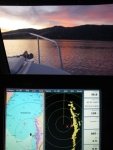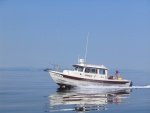Hi Richard, and welcome.
Gaston huh? I remember that. I spent 4 years in a school called Laurelwood, about 4 miles out of town, right at the base of the hill, (Bald Peak), headed east.
Don't let all the bells and whistles from the "toy store" stuff scare you off. You have probably been navigating for most of your life. From home to school, from home to work, from work to the store, to the post office, the bank and home. What is different about doing it on a boat? Much the same, much different ---> but learn it step by step. Just like learning to drive the car.
Yup, no yellow line on the water, and no stop signs and turn signals. WRONG. They are still there, just different. There is still a right of way, (sometimes called the "stand on" vessel). There are still lane markers, (channel buoys or day-marks), separation lanes, and there is still, the place where I am and where I want to go. On the water you can go in any direction, as long as you keep a lookout, and obey the signs.
I would first find a basic boating safety class. Either US Power Squadron or Coast Guard Auxiliary offer them. Then find a basic navigation class with one of those organizations. Take it and try and get a chance to see or put some of that into practice, doing little steps at a time. Try it and you might like it.
What is it about "navigation" that is bothering you? Is it all the buttons on the chart plotters, or the idea of converting numbers (lat and long) to a point on a piece of paper? There is considerable discussion on this site about the use of paper charts vs electronics. You can use the search button at the top of the page to find tons of info on that. It would be helpful to you and us to break down what it is that is most bothersome and then work down from that.
Harvey
SleepyC:moon



